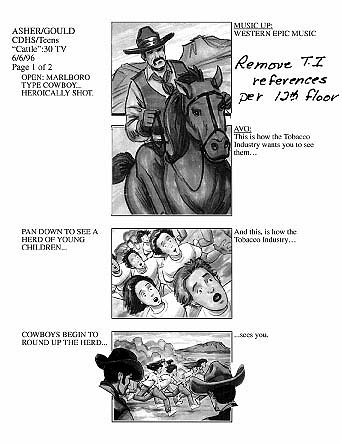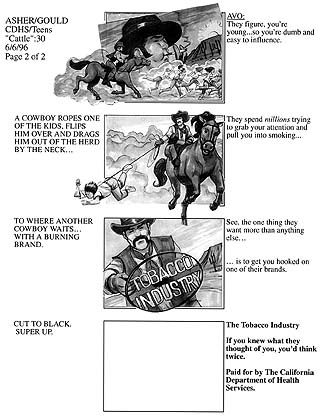Implementing Pringle's Pro-Tobacco Policies
In June 1996 Speaker Pringle had tried to insert language into the budget that would have eliminated the media campaign's attacks on the tobacco industry, meeting a long-standing objective of the tobacco industry. While Pringle lost in the Legislature, the Wilson administration quietly used administrative procedures to accomplish the same thing.
DHS used contracting procedures in an effort to slow down the media campaign. At the time the 1996-1997 budget was signed, the contract to administer the media account was held by the advertising agency Asher/Gould, which had won it in May 1994. This contract contained an option for DHS to renew it for two years, beginning July 1, 1996. As early as June 1996, Asher/Gould had delivered storyboards (pen and ink versions of the proposed advertisements) to TCS for a new media campaign scheduled to begin that fall. Based on the past successes of the campaign, several of these proposed advertisements featured attacks on the tobacco industry.
Rather than simply exercising its option to extend Asher/Gould's contract for two years so that the agency could move ahead with the work, DHS issued a new Request for Proposals for the media campaign on August 2, 1996 (for the period from January 1, 1997, through December 31, 1999). This action set in motion a protracted process of submitting bids, judging proposals, and handling appeals for the agencies that were not selected. Some people in TCS, as well as in the public health community, were concerned that the entire process was designed as an attempt to replace Asher/Gould, since the administration distrusted the agency's president, Bruce Silverman, for consistently pressing for strong anti-industry advertisements. In the end, Asher/Gould won the new contract, but the process delayed the development of the planned advertisements. In a great show of circular logic, the time required for this process became one of the administration's excuses as it came under increasingly strong criticism from TEROC and public health organizations for delays in releasing new advertising.
One of these new advertisements was “Cattle,” which showed cowboys—portrayed as Marlboro Man types—rounding up children as a metaphor for the tobacco industry's efforts to hook kids on cigarettes (figure 24). “Cattle” began with the words “This is how the Tobacco Industry wants you to see them” and was originally to feature one of the cowboys lassoing a kid and dragging him to where another cowboy was waiting with a branding iron labeled “Tobacco Industry.” The final line

Figure 24a. Original version of the television advertisement “Cattle.” As originally proposed by Asher/Gould, the advertisement was a strong anti-tobacco industry message depicting kids being captured and branded by the industry. The handwritten note indicates that the DHS management (“12th floor”) wanted references to the tobacco industry deleted, consistent with administration policy to avoid naming the tobacco industry.
During the summer of 1996, it was reported that Mike Genest, the assistant deputy director for prevention services at DHS and someone who was widely viewed as the governor's political watchdog in the department, and Dr. James Stratton, the state health officer and DHS deputy director for prevention services, summoned Silverman to a closed-door meeting in Sacramento to discuss what would be acceptable and what would not be acceptable in the advertisements that were under development. When Silverman walked into the room, he found four terms written on a blackboard: “tobacco industry,” “profit,” “nicotine addiction,” and “lies.” The DHS managers reportedly stood up and drew a line through each of these terms; they were not to appear in any of the advertisements.
In July 1996 Genest said that everything that Asher/Gould had presented for youth was controversial and would need to be approved several layers up the chain of command.[27] He questioned the efficacy of attacking the tobacco industry, prompting Silverman to write Dileep Bal, head of the Cancer Control Branch (which includes TCS), that “the only effective method I know of to achieve that [a reduction in tobacco use] via advertising is with the `Manipulation' strategy that we just tested.”[28] In addition to expressing general concerns about attacking the industry, Genest wanted the phrase “Tobacco Industry” changed to “Big Tobacco.”[27] Nothing was approved to go into production.
In addition to slowing the approval process, the Wilson administration made other changes designed to tone down and slow up the media campaign. Under previous policy, once an anti-tobacco advertisement was approved, TCS and the media contractor used their professional judgment in deciding when to run it. In August 1996, when Asher/Gould suggested again running “Industry Spokesmen,” the very first Proposition 99 anti-tobacco advertisement (which had not been aired for several years), Genest announced a new policy: every advertisement was to be cleared for each use, even if it had been approved in the past.[29] The approval process included not only DHS management but also the

Figure 24b.
personal stamp of approval of Secretary Smoley. This new policy effectively shelved forty existing television and thirty radio advertisements that had been produced at a cost of millions of dollars to the taxpayers. It also ensured that advertisements such as “Industry Spokesmen,” “Nicotine Soundbites,” and others that the industry found so objectionable
The administration continued to impose tighter political controls on the media campaign. On September 16, 1996, Joe Munso, chief deputy director of the DHS Office of Public Affairs (OPA), the agency's public relations office, distributed a memo announcing that he would “review advertising concepts before they are focus group tested or shared with stakeholders/interested parties” (emphasis in original).[31] Thus, an official charged with protecting the administration's political and public relations positions would review proposed advertisements for political acceptability before any formal evaluation of the advertisements for quality or effectiveness as public health messages could take place. As these delays gradually ground the media campaign to a halt, with nothing but the old, “acceptable” advertisements being run, departmental staff began informing the administration that the advertisements were so overexposed that they had likely lost their effectiveness.[32]
Finally, Belshé wanted TCS to justify not only the attacks on the tobacco industry but also the entire strategy of “countering pro-tobacco influences in the community.” This strategy, along with “reducing exposure to environmental tobacco smoke” and “reducing youth access to tobacco,” was one of the three main themes in all of DHS's programming, including media, local programs, and the competitive grants. Robin Shimizu, a staff member at TCS who was helping with the media campaign, warned Dileep Bal that “these priorities were developed and renewed with the assistance of the tobacco control communities throughout California and do not simply belong to DHS/TCS. To back away from, or to have to justify the use of, any one of them, or to eliminate one of the priorities would be viewed harshly by everyone involved in tobacco control in the state as well as other states, unless there were a very strong rationale for doing so.”[33] Bal forwarded Shimizu's comments to his boss, Don Lyman, head of the Chronic Injury and Disease Control Division, with a comment of his own: “`Countering pro-tobacco influences in the community' is the very signature piece of our efforts to date, as any of the cognoscenti within or without the state will attest to. To have that questioned in an issue memo you or I have not seen is beyond anything. Any fundamental shift of these proportions without community